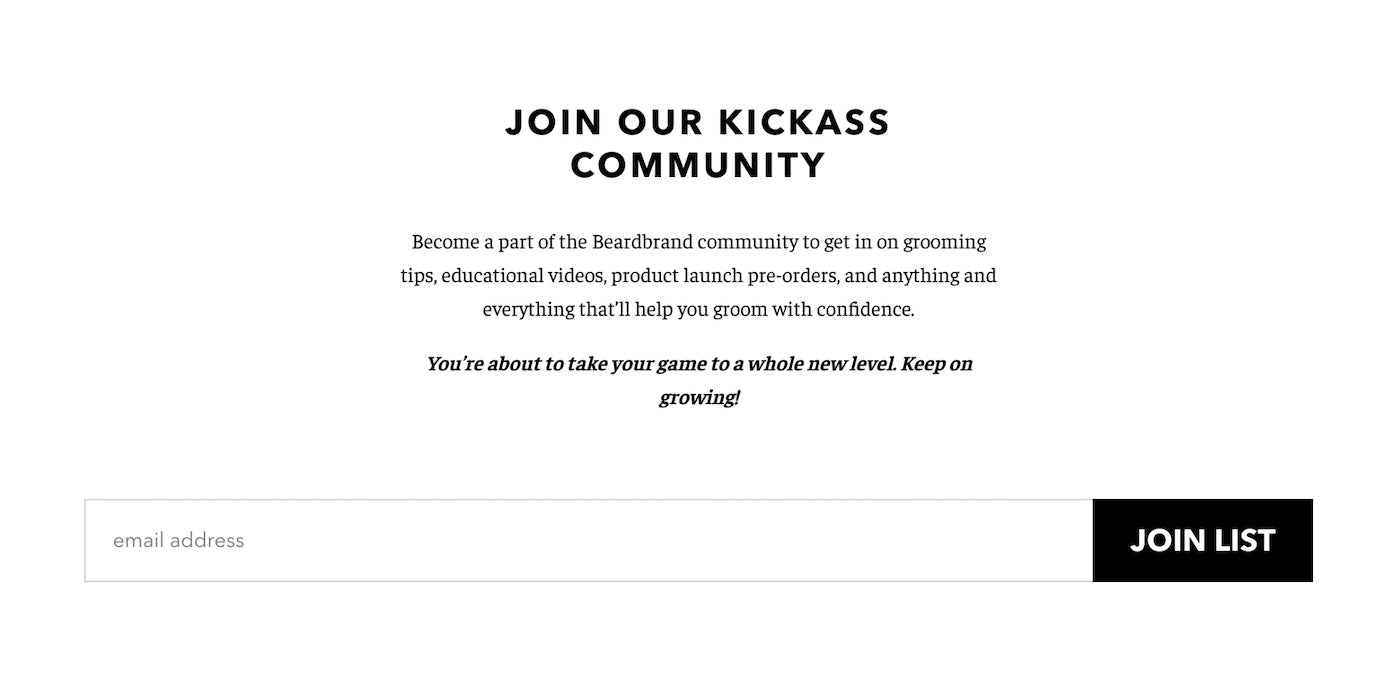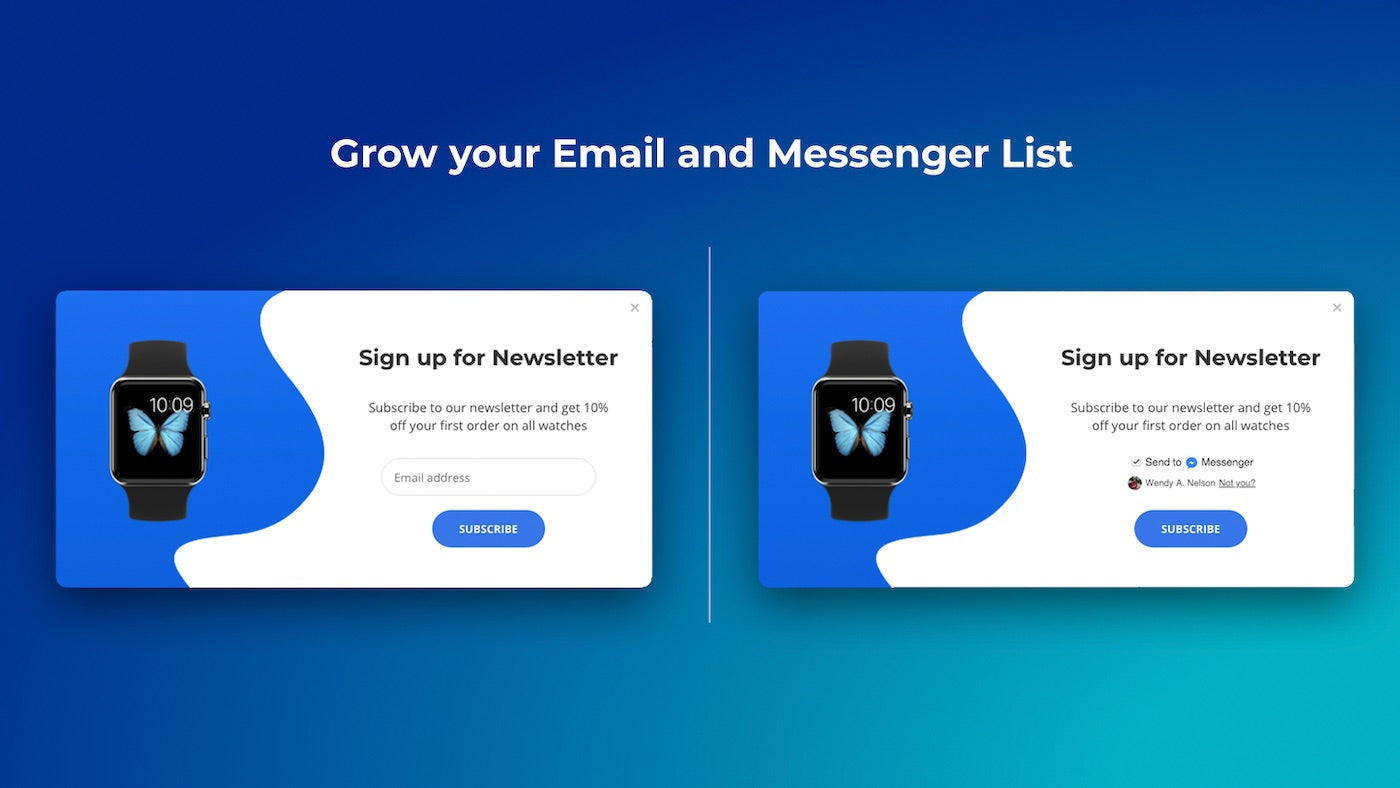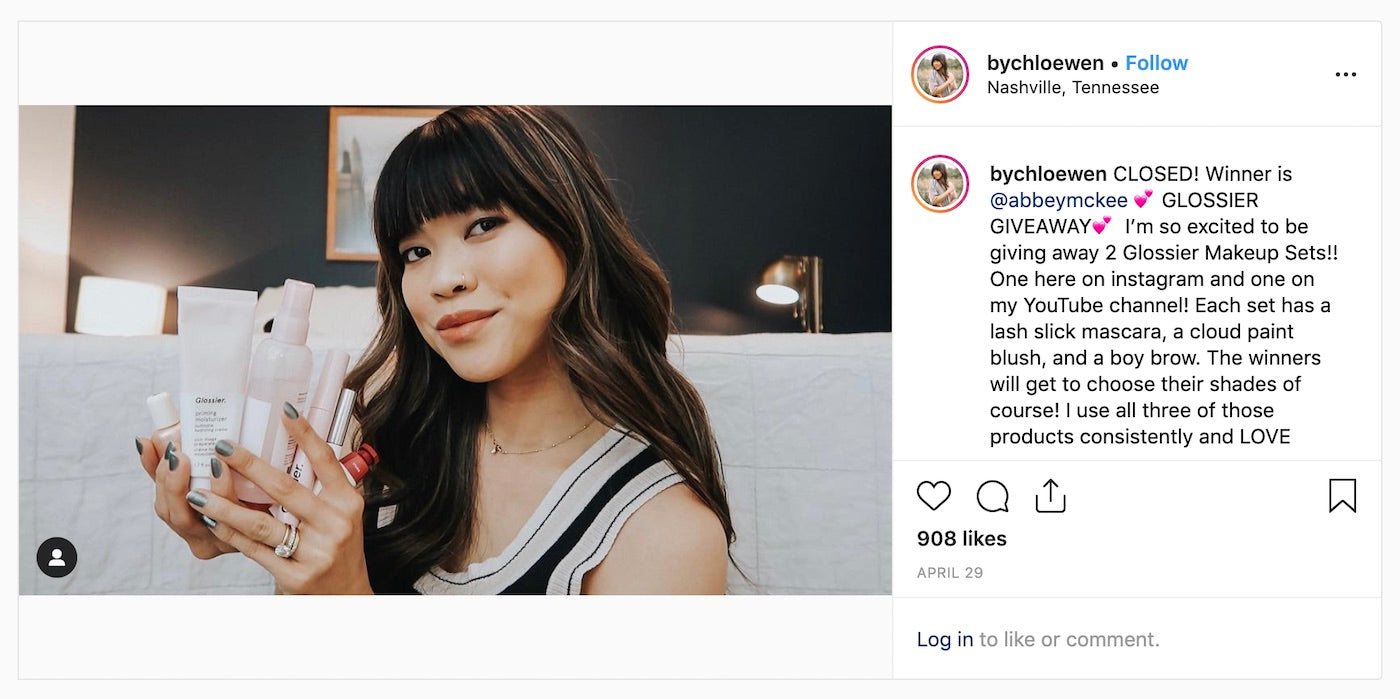It’s not always necessary to place too much emphasis on your ecommerce site’s overall conversion rate, but you’ll probably want to spend a bit of time on first-time visitors, especially from low-intent channels—they’re the ones who are going to need the most convincing on their path to making a purchase. That’s where email marketing can offer outsized value as a channel.
Email, in addition to being the go-to way to save these otherwise lost sales, has strong conversion rates across multiple industries. Data suggests that, on average, businesses can earn $44 for every dollar spent on email marketing, and the average conversion rate for landing page traffic sent through email is 6.05%.
Convincing someone to give you their email address during their first visit to your ecommerce site is easier than convincing them to make a purchase—it doesn’t cost them anything, and you can even layer on incentives, like discounts or a free gift.
To start accruing these benefits and unlock email marketing’s potential, you first need a list of subscribers. You’ll grow your list as you begin generating sales, but why wait? There are steps you can take today to start building your email list before you even sell your first product. Or, if you have a subscription-based business, learn more about subscription based email marketing.
Effective email marketing starts with a targeted list
Successful campaigns start with an email list. Building segmented and targeted email lists is the best way to get going. It’s not worth spending your time building beautiful email campaigns with sophisticated design, engaging copy, and special offers if your lists aren’t properly organized. Three important priorities for building a valuable email list are:
- Quality. Get real information from people—and never buy email lists.
- Relevance. Target people who are genuinely interested in your products.
- Quantity. Once you’ve checked off the first two priorities you can start focusing on volume and growing your list.
Revving up: 5 ways to start building your email list
Like your email list, your website is an important property completely under your control. And since some of your most valuable subscribers will be interested shoppers who didn’t commit to a purchase on their first visit, it makes sense to turn an eye toward your online store as the first place to begin building your list.
1. Add a pop-up offer to your homepage
You don’t want to train shoppers to wait for or expect discounts, but one point in the customer journey where discounts are useful is when a visitor is heading toward the back button. This is your first opportunity to save a potential sale.
Email pop-ups can help. They may be derided by a few customers, but test after test has shown that, with the right offer made to the right audience, pop-ups can dramatically increase your email sign-ups. There are also tests you can run to heighten and personalize your offers while minimizing the perceived annoyance of a pop-up.
To start, trial run an exit intent pop-up on your store. These will only show if a visitor moves their mouse off the page, which usually means they intend to navigate somewhere else. Depending on the targeting options of your tool, you may be able to disable these pop-ups for anyone who’s a previous customer or already on your list. This lets you focus your copy around new customers only.

After visiting a “How It’s Made” post from the Grovemade newsletter, I received an offer of 10% off my first purchase.
Since a visitor lost before their first purchase can be hard to get back, you should consider including a discount of some kind—so long as the math makes sense. Your product’s overall price, profit margins, and potential offer will all determine how viable various discounts are for your business.
2. Try an email sign-up form in your website’s navigation or footer
Locations on your site where shoppers are inclined to look for additional information about your business are usually good places to test small offers.
The conversion rate for these locations will likely be low overall, but the contribution they make to building your list can add up over time. For example, as a shopper makes their way down to your site’s footer to learn more about your brand, what sort of copy might catch their attention and encourage them to subscribe?

Beardbrand describes their newsletter in terms of the value the reader can expect to receive. It’s not just product updates, it’s a place to learn the art of grooming
3. Collect email addresses at your next pop-up event
Temporary pop-up and pop-in shops are a good way for emerging brands to build awareness, get product feedback, and give customers the chance to have a hands-on, tactile experience with a new product. But they’re also a smart way to build your email list.
Remember, forms often associated with email marketing and lead generation can easily make the transition from URL to IRL with just a pen and paper. You can bring a clipboard and ask people to write down their name and email address or, to better sync with your email marketing tool of choice, you can provide an iPad where people can submit their address directly.
Consider making a special offer to encourage your shop visitors to sign up. For example, “Sign up for our mailing list to win at $25 gift card,” or “Enter to win 25% off your first online purchase.”
It’s a good idea to segment these lists by event, so you can send personalized emails afterward.
4. Use a sign-up button on social media channels
There are many reasons why people follow brands on social media, but the prevailing reason given during most surveys is that they want to stay up to date on new products. Since your email list can also help support that outcome, it makes sense to highlight it as another option on your social channels.
Not all platforms are link friendly, but there are usually workarounds. On Instagram, you can use Linktree to include multiple links in your bio. This lets you set one link to direct visitors to a sign-up form for your email list. You may want to consider separating subscribers added through Instagram so you can track roughly how well it’s influencing the growth of your list.
Similarly, you can include a call-to-action button on your Facebook business page to encourage your followers to sign up for your email list.
The next level: 6 ways to accelerate email list growth
Once you’ve laid a solid foundation and started adding new subscribers to your email list, it’s time to look at more advanced tactics: the unconventional approaches that may lead to steep changes in subscriber growth. In the list below, you’ll even find a few out-of-the-box solutions to help you implement a new idea.
1. Use a chatbot to engage with potential customers
Chatbots, a technology still realizing its full potential, already offer a few effective ways to introduce automation into your messaging-focused channels, which can save you valuable time and effort in customer support.
MobileMonkey, for example, allows you to expand the opportunity of messaging by creating marketing campaigns within a custom chatbot. You can share a special offer via your chatbot campaign to encourage users to submit their email address in exchange for a special discount from your shop—not unlike a traditional form, but valuable due to it being an automated prompt and native to a wildly popular channel.
2. Test third-party list growth tools
There are lots of easy-to-use apps to help you build your email list, some of which add clever twists to proven approaches. Better yet, many integrate with your Shopify store. Here are a few to consider:
Spin to Win is an app that can be used to collect email addresses on your website Wheel of Fortune–style. In an interesting, well, spin on the usual pop-up offer, by entering their email shoppers can win various prizes (such as discounts) that you set. Just be thoughtful and cautious about what it might mean if shoppers “lose” this game and miss out on an offer completely.
Personizely includes a host of features to help you prompt visitors with a just-in-time pop-up. What makes it interesting for merchants looking to build their newsletter is the built-in capability to use a traditional form or the Facebook Messenger integration, which gives you the chance to contact Messenger users the same way you’d contact a subscriber on an email list.

Many pop-up tools like, such as Personizely, offer a variety of ways to convert passerby readers to subscribers, whether through email or messaging apps.
3. Run ads to drive traffic to a landing page
Since landing pages are usually built with a single outcome or conversion point in mind, they’re often very useful for building your email list. Not only will you be able to create a specific offer on a distraction-free page, but measuring your results is much more straightforward.
Because of this, landing pages are also a great place to send page traffic. For example, you can create targeted ads on Facebook to drive people to a downloadable guide that connects to your product (such as a recipe handbook if you sell food.) The targeting options available today mean you can build an offer with an audience already in mind, then tweak attributes like location, age, gender, profession, interests, and more to reach the right people.
4. Create a questionnaire to engage with your target audience and collect email addresses
You can create a survey using Google Forms or Typeform to engage with your target audience.
This questionnaire can be for market research or even crowdsourced blog content. You can include a field to collect email addresses and either add a note that lets people know they will get added to your list upon filling out the form or incorporate a question at the end asking if you can add them.
Send your form to friends and family, post it in Facebook groups, mention it on social media, and include a special offer for people who fill it out. For example, you could say, “Upon filling out our short questionnaire, you’ll get a special code for 10% off your first online purchase.”
You might even consider sending out a questionnaire before your product launches. This is a great way to get your email list started and bring friends, family, and potential customers on your startup journey.
5. Offer something for free in exchange for email addresses
Email lists usually lean on the exchange of value in order to encourage people to subscribe, but since readers can’t necessarily “get” any value until your first broadcast, freebies are commonly used to provide a more immediate reward.
Free offers and downloadable how-to content are tried-and-true approaches, but you can also explore partnerships with complementary brands to mix up your offers and gain a promotional partner. For example, if you sell cooking utensils, you might entice subscribers with a $20 gift card to Thrive Market.

Tortuga backpacks offers a free packing list in addition to ongoing tips for travelers, when you sign up for their newsletter.
If you don’t currently have a great understanding of how much the average subscriber is worth to your business, you may want to invest in an offer that has an upfront cost but no ongoing costs once the offer is complete.
A free guide, usually in the form of additional tips and tricks around your product category, is the perfect example. After the cost of your time (and yes, your time is very valuable!) or the associated writing and design fees, you can offer a strong incentive to join your newsletter and you won’t have any recurring costs, aside from hosting the guide itself.
6. Hold contests or giveaways on social media
Contents and giveaways can help accelerate list growth by turning the act of subscribing into a shareable event. The added momentum of a contest can be especially valuable in the early days, when your list of subscribers is small and you don’t have existing traffic to leverage.
One way to multiply this strategy is by partnering with other ecommerce brands who sell to similar customers. With the right partner, your products will complement each other, making the offer more compelling than if you ran the contest alone.

Another option is to look for influencers who are already reaching your ideal customers. Since influencers often use giveaways for their own purposes—typically, to break through the noise and grow their following—you may be able to justify the cost of offering your product in exchange for their ability to kickstart your giveaway campaign.
If you want to create a dedicated landing page for your giveaway so there’s a single destination and traffic is easier to track, you can try solutions like ShortStack or ConvertFlow.
Building an email list is not one size fits all
No two businesses are exactly alike, so it’s important to test various strategies for building your email list to find what works best. Depending on how valuable email marketing is as a channel for your company, your investment in growing your list may be different, too. In either case, we hope these tips helped spark creativity and will get you started on building a quality email list for your ecommerce store.
What list building tactics helped you build your email list? Let us know in the comments below.
